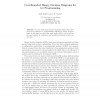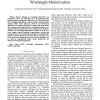42 search results - page 1 / 9 » Representational Correspondence as a Basic Principle of Diag... |
140
click to vote
KNINVI
2005
Springer
15 years 5 months ago
2005
Springer
The timeworn claim that a picture is worth a thousand words is generally well-supported by empirical evidence, suggesting that diagrams and other information graphics can enhance h...
108
click to vote
CVPR
2006
IEEE
16 years 2 months ago
2006
IEEE
Coarse-to-fine classification is an efficient way of organizing object recognition in order to accommodate a large number of possible hypotheses and to systematically exploit shar...
135
Voted
CPAIOR
2007
Springer
15 years 6 months ago
2007
Springer
Abstract. In recent work binary decision diagrams (BDDs) were introduced as a technique for postoptimality analysis for integer programming. In this paper we show that much smaller...
94
Voted
ICCD
2006
IEEE
15 years 9 months ago
2006
IEEE
—In-place flipping of rectangular blocks/cells can potentially reduce the wirelength of a floorplan/placement solution without changing the chip area, In a recent work [Hao 05], ...
97
Voted
IIE
2008
15 years 12 days ago
2008
Abstract. Learning Objects (LOs) play a key role for supporting eLearning. In general, however, the development of LOs remains a vague issue, because there is still no clearly defi...


